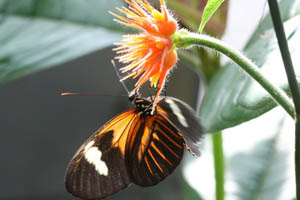Submitted by Administrator on Mon, 29/07/2013 - 15:49
The stunning wing patterns of Heliconius butterflies have inspired biologists since the time of Darwin. In a paper published in Science, researchers from Cambridge, California, and Panama have shown that a gene called optix is responsible for painting red patterns onto Heliconius wings.
 This shows how a single master switch gene, previously known for its role in eye development, can regulate complicated patterns.
This shows how a single master switch gene, previously known for its role in eye development, can regulate complicated patterns.
Brightly coloured south American butterflies often share virtually identical patterns, even between species that aren't close relatives. This mimicry was one of the earliest examples used to support Darwin's theory of natural selection. The idea is that edible butterflies benefit from similarity by fooling predators into thinking they are something bad to eat. Inedible butterflies also benefit from looking alike, because predators learn to avoid them faster when the pattern is shared among many individuals.
What has mystified biologists however, is how so much diversity has arisen in these patterns. In particular, in two related species, Heliconius melpomene and Heliconius erato, wing patterns change every few hundred kilometres across South America. And the two species change in parallel – wherever they coexist the two look identical. How can different species manage to evolve the same patterns again and again across their range? Researchers in Cambridge have previously shown that the same region of the genome is responsible for controlling similar patterns in the two species.
It now turns out that a gene previously known for its role in eye development in fruit flies also controls these red patterns. The control gene optix (a class of genes known as transcription factors) is expressed in a way that perfectly prefigures red wing patterns in a diversity of Heliconius species. In fact, optix expression is so perfectly correlated with wing pattern that it would be possible to identify the species of butterfly solely from its gene expression patterns.
This connection between eyes and wings is not a complete surprise – it has been known for some time now that the colours in many butterfly wings are generated by a class of pigments found in the eyes of all insects. So when there was an evolutionary need for bright colours, butterflies didn't invent the colours from scratch, but instead just moved them from their eyes to their wings. What is new is the discovery that it wasn't just the pigments that were transferred - the genes controlling wing patterns have undergone a similar move, from an ancestral role in eyes, to a new function in wings.
http://www.sciencemag.org/content/early/2011/07/20/science.1208227
